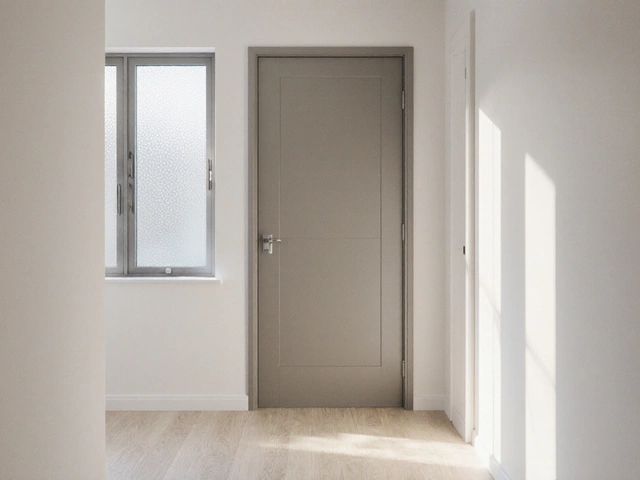
When you step into the world of mortgages, you quickly notice a hefty difference between commercial and residential rates. This gap often stirs curiosity, especially among budding entrepreneurs and property investors. The reasons behind this disparity are not merely about numbers; they encompass a spectrum of factors including risk, property specifics, and investment goals.
Each type of mortgage serves unique purposes and involves a different kind of commitment. Residential properties typically serve as personal dwellings, often viewed with lower financial risk. On the other hand, commercial properties are business-oriented, with an expectation for revenue generation, adding complexity and variability to the equation.
This article peels back the layers of this topic, offering useful insights into why commercial mortgage rates rest a notch higher, and what you, as an investor, should keep in mind when navigating this intricate landscape.
- Risk and Investment Factors
- Types of Properties and Their Impact
- Loan Structures and Terms
- Tips for Navigating Commercial Rates
Risk and Investment Factors
When diving into the arena of commercial mortgage rates, the concept of risk takes center stage. It's essential to remember that lending institutions perceive commercial real estate ventures as inherently riskier than their residential counterparts. This is primarily because commercial properties are closely tied to business success. If a business falters, so too does the property's financial viability, which can make it a challenging asset to back. Residential real estate, on the other hand, generally provides more stability since people always need a place to live, reducing the chance of widespread vacancies.
Investors face unique considerations in commercial property ventures. These types of investments are not just about acquiring a property; they’re often about developing a space that generates revenue. Thus, commercial investors typically carry the burden of larger fluctuations in cash flows than residential property owners. An economic downturn can lead to increased vacancy rates in office buildings, retail spaces, and industrial sites, directly impacting the investor’s income. This variability influences banks to set higher mortgage rates to offset the potential risk.
Understanding these dynamics requires recognizing the broader market forces at play. Commercial properties are frequently affected by changes in economic conditions, zoning laws, environmental regulations, and emerging trends like remote work. For instance, the shift towards online retail has dramatically impacted the demand for physical retail spaces. As a result, lenders must consider these evolving factors, which can affect the security and profitability of their investments. "The commercial real estate market doesn't just rest on the present value; it's heavily driven by anticipation of what's to come," shared a notable real estate expert, emphasizing the importance of perception in these markets.
Investment strategies also significantly influence interest rates. While some commercial properties might be developed for long-term investment, others might be aimed at flipping for quick profits. Banks assess these strategies through a lens of risk tolerance. Properties like warehouses or factories may come with longer-term leases and hence, more stability, which can somewhat mitigate risk. However, speculative ventures geared towards short-term gains might attract higher rates due to the uncertainty in return.
Income stability and diversification also play roles in setting commercial mortgage terms. Lenders scrutinize not just the borrower's creditworthiness but also their income streams. A diverse business portfolio can mitigate risks associated with a single cash flow source, potentially offering a more favorable rate. However, businesses relying on a volatile market segment might struggle to secure equally advantageous terms. This factor, often overlooked, is critical when assessing loan structures and terms in the commercial real estate domain.
Lastly, it’s worth considering the resale potential and liquidity of the property. Unlike residential markets, where there are numerous buyers for a variety of properties, commercial properties often cater to niche markets. Thus, the property might be harder to sell quickly without a significant price drop, increasing the perceived risk for lenders. These properties require a thorough analysis and market understanding before proceeding with investment, reflecting why lenders adopt stricter measures compared to residential mortgages.

Types of Properties and Their Impact
When diving into the realm of commercial real estate, the range of property types plays a pivotal role in shaping commercial mortgage rates. Unlike residential properties which largely consist of single-family homes or apartments, commercial properties vary widely, each category presenting its unique financial implications and risks. Off the top, think about office spaces, retail outlets, industrial buildings, and multi-family units. Each of these categories showcases different risk profiles, potential returns, and market dynamics, affecting the loan agreement significantly. Take office buildings as an example; they are often considered more stable compared to retail, which may face unpredictability due to shifting consumer habits and e-commerce growth.
Retail properties, heavily reliant on consumer traffic, can be a gamble in volatile markets. Location, tenant reliability, and retail industry trends can raise the stakes when banks decide on loan terms. Industrial properties, on the other hand, with the rise of logistics and warehousing, demonstrate a more bankable option, often drawing investors due to their strategic importance in supply chains. However, a surge in demand for such spaces doesn't eliminate the complexities involved. Transitioning to multi-family properties, these fall somewhere in between. While they are apt to yield constant returns due to housing demands, their management can be intensive, affecting their appraisal and interest rates.
"Real estate is an imperishable asset, ever-increasing in value. It is the most solid security that human ingenuity has devised." - Russell Sage
Subdividing a little more into these categories, commercial mortgage rates also hinge on factors like property location. Prime urban centers command stiffer interest rates given the elevated property values and intense competition. Meanwhile, rural and suburban areas may offer more modest rates but come with their own risk of lower demand. Additionally, the condition and age of a building influence lender confidence, as older properties might require significant renovations. Developers must weigh these factors alongside their investment goals to ensure sound financial planning and risk assessment. Thus, this multiplicity in property types underpins the pricing strategies lenders adopt, shaping the commercial mortgage landscape as a highly nuanced field.

Loan Structures and Terms
When delving into the realm of commercial mortgage rates, understanding loan structures and terms is crucial. These components often seem labyrinthine, especially to new investors, but they play a critical role in why commercial rates typically float above those of residential properties. One of the primary reasons for this complexity is the customizable nature of commercial loans, designed to cater to the varied objectives of businesses. Unlike a traditional home mortgage with a standard set of terms, commercial loans can be tailored — whether it's for a retail center or an office complex, each deal is unique.
Commercial loans often come with shorter terms, usually 5 to 20 years, compared to the conventional 30-year residential mortgage. This shorter horizon reflects the higher real estate investment risk associated with commercial properties. The restructuring period at the end of the loan cycle also adds an element of uncertainty, which lenders hedge with higher rates. These loans might include variable interest rates that adjust periodically, making them riskier for both parties, yet potentially more rewarding for lenders. It's this potential for variability that necessitates the higher interest to cushion against an array of market fluctuations.
The decision-makers behind these loans are acutely aware of several metrics; from property cash flow to the borrower's business acumen. The debt service coverage ratio (DSCR) is often employed — measuring net operating income against total debt service — and applications boasting a higher DSCR are usually in a stronger bargaining position, potentially securing better terms. Commercial lenders will frequently seek collateral as assurance, often with a more stringent vetting process compared to residential credits. This security net, while safeguarding the lender, also elevates the borrowing stakes significantly.
"Our experience is that robust collateral can make a world of difference in negotiations," notes a strategist from a leading financial institution.Decisions about the loan structure are not just about repayment plans. They're a dance between securing favorable terms and mitigating risk, each party striving for equilibrium in a deal where stakes are high. The rate itself becomes a reflection of this balance, accounting for varying loan-to-value ratios, credit scores, and tenure of the borrower’s enterprise. The specificity and variation in construction loans for commercial purposes introduce another complex layer, often involving phased disbursements and continual project assessments.
The versatility of these loans extends to repayment alternatives, which might include staggered installment plans or balloon payments, where the loan terminates with one larger final payment. These structures are crafted to suit the revenue cycles of businesses, often predicting cash flow fluctuations that differ significantly from that of residential mortgages. Mastering these terms involves a keen understanding of the market and a strategic approach to borrowing, ensuring the commercial property’s potential is fully realized while securing your enterprise’s financial health.

Tips for Navigating Commercial Rates
Diving into the labyrinth of commercial mortgage rates can feel daunting, but with the right guidance, you can steer your journey toward more favorable terms. Understanding the nature of commercial mortgages as opposed to residential ones is crucial. The stakes are higher, involving significant amounts of capital, with fluctuating market conditions often playing a role. Your approach to securing a better rate hinges on several elements, primarily your knowledge of the market, your negotiating skills, and your understanding of lender expectations.
One of the first tips is to do your homework on the specific types of properties in your desired area and understand how each one influences the mortgage landscape. Commercial properties vary widely from office spaces to retail stores, each with unique risk profiles that affect rates. A well-researched borrower has a clearer vision of what to expect, aligned closely with their financial blueprint. Knowledge here equates to power, enabling you to project confidence in discussions with lenders.
Real estate investment strategies can also benefit from diversification, much like a balanced stock portfolio. By not putting all your eggs in one basket, you protect yourself from the ebbs and flows of any single market segment. This diversification might not directly lower your rates but can improve your overall financial standing, which can be immensely beneficial when discussing loan terms with your lender. It's worth noting that a strong financial profile doesn't just appeal to basic risk assessments; it can also lead to enhanced lending conditions.
When negotiating, remember, everything is subject to discussion. Engaging in a conversation about loan structures or term adjustments shows you're an informed consumer, which can sometimes result in better offers. It can be as simple as asking for different amortization periods or competitive rate match-ups that other lenders might offer. Be frank about your needs and don't shy away from asking for what you believe is advantageous for your growth.
Seek Professional Guidance
Consider hiring a mortgage broker with a sparkling reputation in the commercial sector. These professionals possess a depth of knowledge and have access to a broader range of loan products than what's available to the everyday borrower. They can assist in demystifying complex terms, ensuring you're aware of hidden fees or potential pitfalls. Their established rapport with lenders might give you access to exclusive deals, ultimately affecting your commercial mortgage rates positively."A dedicated mortgage broker can be the difference between good and great loan terms," remarks Susan Jenkins, a leading real estate advisor. "Their experience allows you to navigate the complicated maze with informed choices."
Finally, always review the fine print attentively. Loan agreements are meticulously detailed, often hiding clauses that could affect your business considerably if left unchecked. By thoroughly scrutinizing every document, you safeguard your enterprise from unwelcome surprises in the future. Successful navigation comes down to a blend of due diligence, market awareness, and strategic collaborations. Each decision you make in this domain should be an informed one, laying a foundation for sustainable financial health.




